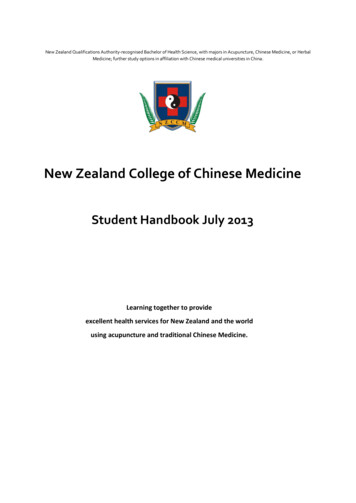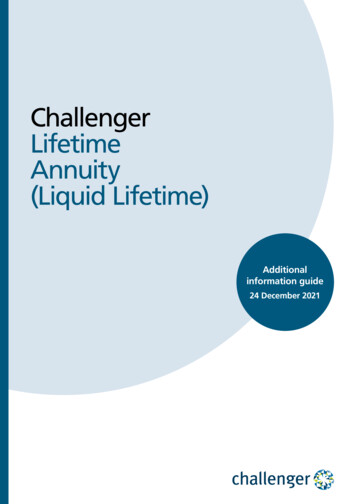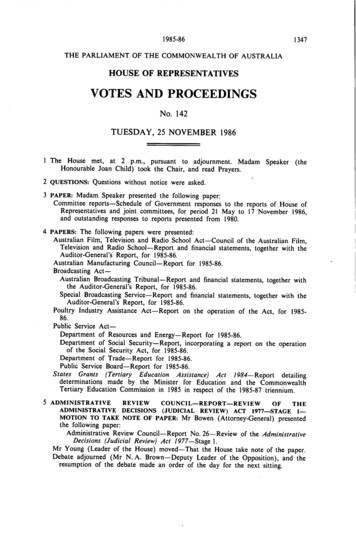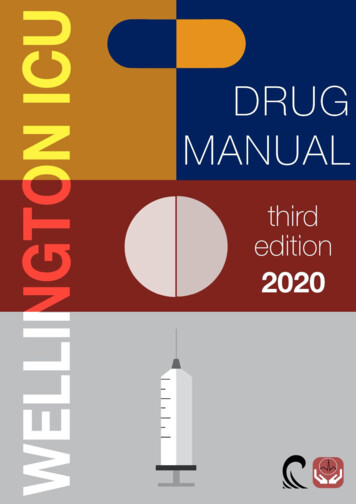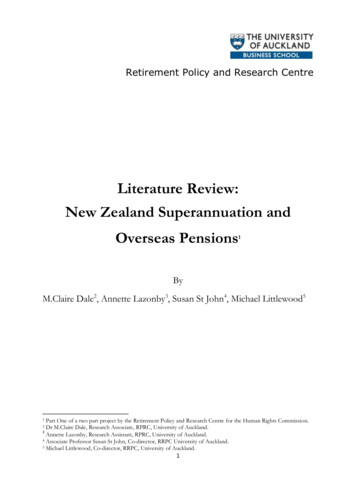
Transcription
Retirement Policy and Research CentreLiterature Review:New Zealand Superannuation andOverseas Pensions1ByM.Claire Dale2, Annette Lazonby3, Susan St John4, Michael Littlewood5Part One of a two part project by the Retirement Policy and Research Centre for the Human Rights Commission.Dr M.Claire Dale, Research Associate, RPRC, University of Auckland.Annette Lazonby, Research Assistant, RPRC, University of Auckland.4 Associate Professor Susan St John, Co-director, RRPC University of Auckland.5 Michael Littlewood, Co-director, RRPC, University of Auckland.1231
The Retirement Policy and Research CentreThe Retirement Policy and Research Centre is pleased to publish this Literature Reviewon New Zealand Superannuation and overseas pensions. It provides essentialinformation on a difficult and contentious area. We hope it will inform the policydevelopment process.We thank the Human Rights Commission for sponsoring and supporting the developmentof this Literature Review and the forthcoming Working Paper that builds on the research.The RPRC welcomes comments and criticisms of this paper.Comments should be addressed to Dr M.Claire Dale: m.dale@auckland.ac.nzDr Susan St JohnMichael LittlewoodJune 20092
Table of Contents:Introduction . 4Economic issues . 7Migration and economic efficiency . 8Migration‘s challenge to a country‘s policy settings .10Portability of pensions – the EU experience .12European pensions .12Integrating with our closest neighbour .13Australian pensions.14The Human Rights framework .15Equity issues.16Administrative simplicity and transparency .17Demographic and gender issues .18New Zealand‘s policy on overseas pensions .19Pacific provisions .20Ministry of Social Development‘s reviews of pension portability .21The 2007 – 2008 review of pension treatment in New Zealand and overseas .24Recent developments .27Summary .30Appendix 1: Special Portability of NZS or Veteran‘s Pension .31Appendix 2. Press Release from the Minister 2008 .33Appendix 3. Budget 2008 Initiatives: Payment of NZS and Veteran‘s Pensions overseas 34Appendix 4. Overseas Pensions and payment of NZS and Veterans Pension .36Appendix 5. New Zealand Superannuation and Veterans Pension rates at 1 April 2009 .38Appendix 6. Social Assistance ( ) Amendment Bill .39Appendix 7. Social Security Act 1964, sections 69, 70 .41Appendix 8. The Social Security (Overseas Pension Deduction) Regulations 1996 .43References .443
Literature Review: New Zealand Superannuation andOverseas Pensions.IntroductionThis literature review surveys recent academic and government publications in NewZealand and overseas relating directly and indirectly to pension portability and migration.The purpose of this Review is to provide the foundation for the forthcoming RetirementPolicy and Research Centre (RPRC) Working Paper: New Zealand Superannuation andOverseas Pensions: A first principles approach to developing options to improve equity.That Working Paper, which draws on Lazonby (2007),6 an earlier RPRC Working Paper,will analyse the existing complaints, policy, legislation and recommendations regardingthe treatment of overseas pensions.The primary focus of this literature review is the treatment of public pensions in relationto migration. Cash incomes for retired people in developed countries can be groupedinto three major categories: public pensions, private and occupational pensions orsuperannuation, and income from private investment and savings. There are threedifferent types of public pensions: social insurance based on individual contributionswhich pays earnings-related pensions; social assistance which is means-tested and is forpoverty alleviation; and universal pensions which are paid at the same basic rate to allregardless of wealth or contributions (for further discussion see Preston, 2008). Whilepublic pension schemes are essentially pay-as-you-go schemes whereby currentcontributions meet current outgoings, they may also be partly ―funded‖ as in the USwhere contributions are paid into a trust fund. There may be other public involvement inprivately managed schemes, either through compulsion or subsidisation.This literature review sets out the economic, social and theoretical issues as portrayed inthe general literature; and provides a summary of policy developments in New Zealand.The exercise is timely in view of new legislation currently before Parliament. The SocialAssistance (Payment of New Zealand Superannuation and Veteran‘s Pension Overseas)Bill, introduced on 22 August 2008 with its first reading on 31 March 2009, is discussedin detail in the final section of this Review. It will alter many aspects of the existing lawsregarding pension payments overseas.A preliminary analysis of complaints received by the Human Rights Commission (HRC),the Ministry of Social Development (MSD), the RPRC, and the New Zealand PensionAbusewebsite (to be summarised in the forthcoming Working Paper) highlights the problems oflanguage and understanding for academics, professionals, and the general population.There are no internationally agreed definitions of the terms used in the sector, andproblems emerge from perceptions of ―eligibility‖ and ―entitlement‖ to ―unfunded‖ and―contributory‖ pensions. A private saving scheme, perhaps referred to as ―funded‖, mayor may not be mandatory, but delivers benefits that relate to the accumulated funds.―Pay as you go‖ (PAYG) state schemes, whether or not there is some prefunding, areoften described as ―unfunded‖. They may have a contributory basis with individualspecified contributions, or they may be paid out of general tax deductions.6RPRC‘s Working Paper, Passing the Buck, 2007, examined New Zealand‘s retirement income system, andreviewed the origins of the direct deduction policy, its rationale, and its impact on those receiving overseaspensions.4
New Zealand‘s retirement income system comprises New Zealand Superannuation (NZS),a universal Tier 1 pension,7 paid at a rate unrelated to previous earnings, depending onlyon marital status and living arrangements.8 NZS is supplemented by KiwiSaver, avoluntary, quasi-Tier 2 government-subsidised scheme,9 implemented in 2007, withcompulsory employer contributions up to 2% of member‘s gross pay. There are also Tier3 superannuation schemes that are voluntary, usually workplace-based, some of whichare subsidised by employers. All other voluntary saving arrangements are unsubsidised.Administrative simplicity is a major advantage of New Zealand‘s universal, non-meanstested old age pension. Other advantages of such pensions are that they directly addressthe poverty issues faced by the old; they are easy to administer; and they aretransparent. Yet only nine countries plus one city pay a universal pension with no testother than citizenship, residence and age. They are New Zealand, Mauritius, Namibia,Botswana, Bolivia, Nepal, Samoa, Brunei, Kosovo and Mexico City. ―These universal nonmeans-tested pensions automatically protect an entire population, in a way thatcontributory, earnings-related pensions never can.‖ (Willmore, 2007, p. 24)New Zealand‘s regime, with the current interpretation of the Social Security Act 1964(SSA) and the direct deductions policy (DDP) set out in section 70 of that Act,10 reducesNZS dollar for dollar against government administered, unfunded overseas derivedpensions.NZS eligibility and entitlements are set out in The New ZealandSuperannuation and Retirement Income Act, 2001 (NZS Act 2001). As with governmentadministered basic pension arrangements in many other countries, entitlement to NZS isconditional on reaching a given age (65) and a minimum residence requirement.However, unlike most other countries there are no specific contributions or work-relatedrequirements. At least 10 years must be lived in New Zealand over the age of 20, withat least five of these after the age of 50 (―the 10(5) Requirement‖). The recipient mustalso be resident in New Zealand at the time of application. The NZS Act 2001 states:―the purpose of this Act is (a) to continue current entitlements to New ZealandSuperannuation‖; and in Part 1: ―(1) Every person is entitled to New Zealandsuperannuation who attains the age of 65 years.(3) subject to the provisions of thisPart and of the Social Security Act 1964.‖ It is therefore not surprising that many in NewZealand have a sense that they are entitled to NZS once they reach the age of 65.Universal entitlement to NZS may be viewed as a recognition of the paid and unpaidcontributions of older citizens (TeAra.govt.nz, 2006); it is not dependent on contributionsout of income from paid work, nor is it intended to be a poverty-alleviation device(though it serves this purpose well). However, although NZS is termed ―universal‖ noteveryone who is eligible prima facie is entitled to receive it. The NZS Act 2001 providesfor the NZS ―entitlement‖ to be reduced against benefits received under the InjuryPrevention, Rehabilitation and Compensation Act 2001, and in accordance with the DDP.7Definitions of the pension ―Tiers‖ are discussed fully in the Working Paper. For the purposes of this Review,Tier 1 (e.g. NZS) are basic state pensions. Tier 2, earnings-related pensions, with mandatory contributions byemployees, employers or both, can be complicated by the addition of state subsidies and tax concessions. Tier3 covers all other voluntary savings, whether through the workplace or directly; through formal saving plans,by direct investment or by paying off debt. Tiers 2 and 3 are often referred to as ―supplementary pensions‖ (forexample, Hunt & Wallace, 2006).8The three basic NZS rates are ―married‖, ―single sharing‖, and ―single living alone‖.9KiwiSaver is a Tier 3 scheme: employee contributions are voluntary, however their membership in the schememakes employer matching contribution of 2% mandatory, thus making KiwiSaver quasi-Tier 2. KiwiSaver isoften a concern for recipients of overseas pensions as they note its similarity to the pension systems of theirown country as a means of retirement saving.10See Appendix 7 for Section 70 of the Social Security Act 1964.5
The application of the DDP may seem inconsistent with the otherwise universal nature ofNZS, and may seem to infringe human rights legislation. The human rights frameworkshapes the approach and method employed in this literature review and in thesubsequent Working Paper. Particular attention is given to identifying discrimination andinequity in the associated policy, legislation and practice. As Table 1 (below) shows,more than 10% of the approximately 500,000 New Zealanders over age 65 are entitledto the public pension, NZS, and at least one other public pension from abroad.Numerous complaints received annually by the HRC, the MSD, the Minister of Finance,and RPRC, or published on www.pensionabuse.co.nz, indicate that the DDP under section70 of the SSA has produced a sense of injustice in many of the affected pensioners.Table 1. Trends in Work and Income Clients receiving overseas pensions, by source country.(Source: Ministry of Social Development, 2008c, p. 176)6
In New Zealand, pension system and policy issues, problems and complexities areexacerbated by a lack of clear policy intent; by the lack of international agreement on thedefinitions of the three different pension ―Tiers‖, and hence on the nature of the pensionsthat should be subject to the DDP; and by the lack of clarity in the information providedto immigrants regarding pension portability and entitlement.Pension systems in other countries tend to be complex amalgams of the tiers and providea sharp contrast to the simple Tier 1 New Zealand pension system. For exampleCanada‘s system comprises: a universal, flat-rate, income-tested pension known as ―oldage security‖ which can be topped up with the second Tier 1 component, an incometested benefit, the ―guaranteed income supplement‖, and a third Tier 2 layer of statedelivered earnings-related benefits called the ―Canada Pension Plan‖ or the ―QuebecPension Plan‖ (Whitehouse, 2003, p. 13). The US system is just as complex, while theUK system‘s complexity makes it almost incomprehensible to all but pension specialists(O'Connell, 2006). The complexity of, and wide variation between pension systemsmakes establishment of reciprocal agreements between countries difficult. It also makesit difficult for individuals to determine the benefits or fairness of any particular pensionsystem, and to make their decisions on whether or not to emigrate, and if so, to where.This review of the local and international literature begins with economic issues related tomigration and public pensions. Attention is given to emerging pension portability andpolicy issues,11 and recent European experience provides some useful examples. Thissection is followed by an overview of the Australian pension system. Focus then shifts toNew Zealand, with an outline of a human rights framework preceding a discussion ofequity, administrative simplicity and transparency, and demographic (including gender)issues. A selection of New Zealand‘s pension policy and legislative documents areprovided in the Appendices. Finally, a short history of recent overseas pension reviewsand proposed changes, including the 2009 Social Assistance (Payment of New ZealandSuperannuation and Veteran‘s Pension Overseas) Amendment Bill, are outlined withsome commentary on the progress to date.Economic issuesThis section examines the literature on the economic efficiency of labour mobility withrespect to different pension systems; the role that preferences and rationality play inmigrants‘ decisions; and the impact of labour mobility on the ability of a country todetermine its own policy settings. The issue of private pension portability is also exploredand issues discussed in the literature that pertain specifically to Europe and the US.As people have become more mobile, the economics of migration has become a recurringtheme in the academic literature on inter-country pension portability issues and policy.The motivations for and consequences of inflows and outflows of migrants are complex.From the perspective of the individual, households may migrate for lifestyle reasons,because of family connections, or because of economic motivations. The economicbenefits of migration may include higher wages from employment, lower taxes or greatersocial benefits. The nature of the welfare system, including the pension system, issometimes referred to as the ‗indirect wage‘ or ‗social wage‘ that workers receive whenmigrating to another country (Freeman, 1986 p.55). Workers may migrate to a country11See Appendix 1: Special portability of NZS or Veteran‘s Pension.7
which pays them a higher social wage, even when it does not pay them a higher wagefrom employment.Factors that affect migrants‘ decisions include not only the institutional set-up of thecountry, the taxation and benefit regime, but also the physical environment; the paceand nature of the employment environment; the schooling system; the presence offamily in the destination country; and a number of individual preference factors that aredifficult to measure. Individuals take account of ―their access to the labour market,relevant net amounts of (household) income to be earned, local costs of living, and theexistence of networks of co-nationals or members of their ethnic groups who moved tothe host country at an earlier stage‖; and individuals also migrate from low-wagecountries to high-wage countries (Munz & Werding, 2005, pp. 204 - 205) .Although it may appear that wages (net of taxes) are the main driving force behindmigration decisions, Wildasin (1999, p.16) notes that differentials in public pensionprovision between countries are not an insignificant motive. On the other hand, Munzand Werding (2005, p. 205) note that public pensions can entail an ―entrance fee‖ forpotential migrants, and therefore can ―create a barrier for voluntary migration, evenwhere it would be beneficial in terms of an optimal factor of re-allocation‖. In the case ofmigration to New Zealand, the DDP may be considered by some as a fairly steep―entrance fee‖.Migration and economic efficiencyFrom a country‘s policy perspective, countries may encourage free labour mobility inorder to make economic gains from importing skilled labour (Andersen, 2003); or tochange the age structure of the population through importing younger, typically lowerskilled workers (Kemnitz, 2003; Razin & Sadka, 2000). However, labour mobility maypose challenges for a country in terms of reducing the efficiency of a country‘s policies;or reducing the degree of determination a country may have over its own policy settings.A pension system is ―economically efficient‖ if it does not distort decisions; that is, ifpeople have no incentive to alter their behaviour based on pension benefits they maypotentially receive from taking a particular course of action. ―Internal efficiency‖ requiresefficiency within the country (assuming no labour mobility) while ―external efficiency‖12allows for labour to be fully mobile between countries.An internally efficient pension system does not distort the decisions of people who liveand work within a country all their lives. For example, NZS is generally internallyefficient, as the flat-rate entitlement is almost universally available to all at age 65.There is no distortion of the retirement decision, as people receive it regardless ofwhether or not they choose to retire at age 65. There is no incentive for individuals toshift their assets around, or to reduce their income, as the pension is not means-tested.13When a country‘s labour market is open to migration, as in New Zealand, the pensionsystem (which includes the treatment of overseas pensions) may be considered12The first examination of external efficiency was in Oates‘ (1972, cited in Wildasin, 1997) work ondecentralisation of public goods‘ provision. Wildasin (1991) and (1994) expanded on this and applied it tobroader issues of a common labour market, and later (1997, 2000) to pension provision, suggesting thatpension systems in different countries may give rise to adverse selection.13An exception occurs in the case of the non-qualifying spouse provision. This is where an NZS recipient mayhave a spouse who is under 65 but wishes to receive the pension; they may do so subject to an income test.The household therefore has an incentive to reduce their direct income until it is under the threshold (portfolioinvestment income (PIEs) or other super scheme income will not count).8
externally efficient if it does not distort labour market flows. On the other hand, apension system may be externally inefficient if it gives rise to adverse selection,attracting those who are most expensive to the system and discouraging those who couldsubsidise the system. When a country opens its borders, adverse selection may arise ifthe country‘s system attracts net beneficiaries (typically low-skilled, low-productivityworkers) and repels net contributors (typically high-skilled, high-productivity workers).A body of literature has emerged from the EU devoted to examining the extent ofadverse selection in the operation of countries‘ welfare states in the presence of labourmobility (Andersen, 2003; Geddes, 2003; Razin & Sadka, 2000; Razin, Sadka, & Swagel,2002; Wildasin, Markusen, & Winters, 2000). The adverse selection theory is thought tohave implications for the sustainability of welfare systems: redistributive countries attractlow productivity workers who intend to benefit from the system, leading to an outflow ofhigh productivity workers who would typically subsidise the system, thus the attainabledegree of redistribution is reduced.Much of the research mentioned above relates the adverse selection effect to welfaresystems in general, but a subset of this literature examines it with respect to pensionsystems (Cremer & Pestieau, 2003; Geide-Stevenson, 1998; Kolmar, 2007; Poutvaara,2007). The ―conventional wisdom‖ in these papers suggests that Beveridgian pensionsystems (flat-rate pensions) will ―select out‖ the highest productivity workers whilstBismarckian systems (earnings related pensions) will ―select in‖ the high productivityworkers. Consequently the conventional wisdom suggests that Beveridgian pensionsystems would not survive in competition with Bismarckian systems (Kolmar, 2007).New Zealand has a redistributive pension system with Beveridgian principles (pensionbenefits are paid at a flat-rate). The ―conventional wisdom‖ regarding the efficiency ofsuch a system holds that New Zealand, therefore, ought to attract lower-productivityworkers, and overall have lower gross domestic product (GDP) growth. Fully-informed,forward-looking individuals and households are expected to take into account lifetimeincome when they make their migration decisions; hence they include the retirementincome system of their destination country as a parameter in those decisions. However itis called ―conventional wisdom‖ for a reason: an emerging subset of literature arguesagainst pure adverse selection in public pension provision. For example, Poutvaara(2007) notes that the migration decision is not based solely on wage differentials. Shesuggests that, where people have formed family connections, or face other potentialbarriers to migration that may arise during early working life, they are unlikely tomigrate.14Informal institutional factors appear to pose one of the biggest challenges to the adverseselection story. Kolmar (2007) notes that evidence on migration patterns between EUcountries shows that overall migration, or labour mobility, is still relatively low despitethe reduction of formal institutional barriers. Andersen (2003) suggests that, even withinthe EU, cultural and linguistic barriers are the likely reason for the relatively low labourmobility. However proximity to the destination country may also play a role. Lucas(2008) argues that, at least for low skilled labour from developing countries, distance isthe largest barrier to migration.14The potential for migration to a country that gives a higher return on labour (that is, a less redistributivecountry) could induce people to invest more in human capital and becoming skilled than they may otherwisedo. Thus the model suggests that free labour mobility may make both countries better off: the Bismarckiancountry attracts higher skilled workers from the Beveridgian country, but keeps those workers who investedmore in their human capital due to the possibility of migration, who then found themselves unable to move.9
―Proximity‖ and ―similarity‖ arguments have relevance for New Zealand which attractsmigrants for both reasons, although those reasons may operate separately. Migrantsfrom the Pacific and possibly Asia may be attracted for proximity reasons,15 and migrantsfrom the UK and Europe for similarity reasons, yet the human and physical capital levelsof these three different groups of migrants tend to be different.The degree to which migrants rationally take the prevailing pension system into accountwhen they choose to migrate to a particular country is open to question. Households canbe myopic; or they can heavily discount returns received in the future compared to thosereceived more immediately. There would also be a degree of uncertainty with themigration decision due to incomplete information. Migrants must rely on testimonialsfrom friends and/or family, and publicly provided information. Testimonials from friendsand/or family are unlikely to be impartial, and as will be shown in the following sections,publicly provided information is unlikely to be either accessible or comprehensible.Migration’s challenge to a country’s policy settingsThe literature notes that a country‘s ability to determine the nature of its welfare statecan be threatened by the level of immigration (Andersen, 2003; Freeman, 1986; Razin &Sadka, 2000). Razin et al (2002, p. 176) suggest that external pressures can result in a―race to the bottom‖. Whereas low income migrants initially support the low incomenative-born population in voting for more redistributive policies, they find thateventually, as more low-income migrants enter the country, the low income native-born(where benefits are spread more thinly) start to vote for lower benefits. Razin et al(2002) support this claim with data from 11 OECD countries showing that an increasedshare of low-skilled migrants in the population results in lower taxes and transfers. 16Some households will prefer a more egalitarian system, such as that in New Zealand,whereas others will prefer a system where ―you get out what you put in‖. The latter typeof individuals may be psychologically repelled by a system such as New Zealand‘s, andthe equalisation of income in retirement may seem like a penalty on high earners.The persistence of New Zealand‘s welfare state and NZS, a universal, flat-rate pensionscheme, may simply reflect the preferences of most New Zealand voters. People whoprefer a system that better equates retirement income to earnings during working yearscan choose to emigrate; and people from overseas who have such preferences would beexpected not to migrate to New Zealand. If they do migrate to New Zealand in spite ofthe pension system, many other features of New Zealand may have been attractiveenough to merit the move. However such immigrants may still exert pressure on thegovernment, including through the legal process, to alter the system to align with theirpreferences. To the extent that such migrants are seen as desirable (in terms of beinghigh-skilled) the pressure they exert may be successful. Consequently there may be athreat to sovereignty over policies from migrants who have entered the country.Another possible threat to a country‘s sovereignty is pressure to alter its system exertedby other countries‘ governments. In 2008, New Zealand‘s MSD reported that theSwedish government refused to continue negotiations towards a social securityagreement until treatment of Swedish pensions (particularly under the DDP) was altered.15The expansion of the Pacific community, and the localising of many Pacific migrants to Auckland, where thePacific community is most visible, may reflect similarity bias in Pacific People‘s migration choice.16After controlling for size of government, degree of openness to trade, dependency ratios and growth rates inGDP per capita.10
In this case, the Swedish government‘s suggestion of a proportional accruals packagewas rejected ―for equity reasons‖ (Ministry of Social Development, 2008a).Though immigration can be advantageous in bringing human capital and diverse skills toan economy, or in changing its age structure to reduce dependency ratios, access of newimmigrants to existing benefit provisions can be viewed negatively. A system whereredistribution is agreed to (voted on) by citizens would be expected to generateresistance to outsiders. Migration generates ―pressures to demarcate more tightly acommunity of legitimate receivers of welfare state benefits‖ (Geddes, 2003, p. 150).This can result in citizens exerting pressure on the government to tighten immigrationpolicies (Freeman, 1986), or using their ability to migrate to avoid redistributive taxes(Andersen, 2003), or remaining within the country and exerting downward pressure onthe degree of redistribution (Razin et al., 2002).The degree to which a welfare system attracts net beneficiaries depends on the degree towhich benefits are decoupled from marketplace performance (Freeman, 1986). Lowskilled outsiders pose less of a threat to the sustainability of a welfare state whenhealthcare and pension benefits are based on employment, because without employmentthere are no benefits, and they return to their home countries (Freeman, 1986). Thishas implications for countries like New Zealand with a ―gateway‖ approach: once theminimum number of years‘ residence is achieved, the migrant is eligible for full benefits.Also, the ―welfare‖ system in New Zealand provides the (admittedly less generous)Emergency Benefit to those aged 65 who do not qualify for NZS.Inequities arise when the welfare system‘s design enables migrants who contributed lessto end up with equal or greater benefits than the country‘s other citizens (Andersen,2003; Cremer & Pesti
1 Retirement Policy and Research Centre Literature Review: New Zealand Superannuation and Overseas Pensions 1 By M.Claire Dale2, Annette Lazonby3, Susan St John4, Michael Littlewood5 1 Part One of a two part project by the Retirement Policy and Research Centre for the Human Rights Commission. 2 Dr M.Claire Dale, Research Associate, RPRC, University of Auckland.

